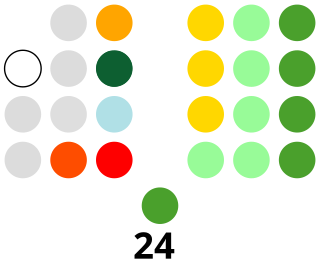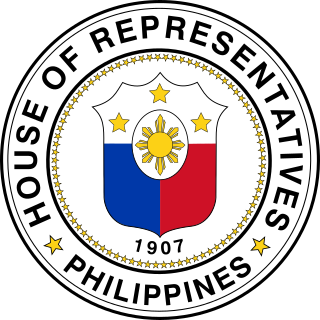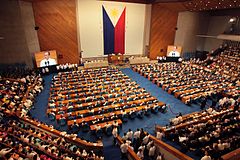
The president of the Philippines is the head of state, head of government and chief executive of the Philippines. The president leads the executive branch of the Philippine government and is the commander-in-chief of the Armed Forces of the Philippines.

The Congress of the Philippines is the legislature of the national government of the Philippines. It is bicameral, composed of a lower body, the House of Representatives, although colloquially the term "Congress" commonly refers to just the latter, and an upper body, the Senate. The House of Representatives meets in the Batasang Pambansa in Quezon City while the Senate meets in the GSIS Building in Pasay.

The House of Representatives of the Philippines is the lower house of Congress, the bicameral legislature of the Philippines, with the Senate of the Philippines as the upper house. The lower house is usually called Congress, although the term collectively refers to both houses.

The Senate of the Philippines is the upper house of Congress of the bicameral legislature of the Philippines with the House of Representatives as the lower house. The Senate is composed of 24 senators who are elected at-large under plurality-at-large voting.

The State of the Nation Address is an annual address by the president of the Philippines to a joint session of the Congress of the Philippines. Mandated by the 1987 Constitution, the speech is delivered every fourth Monday of July at the Plenary Session Hall of the Batasang Pambansa Complex in Batasan Hills, Quezon City.
A joint session or joint convention is, most broadly, when two normally separate decision-making groups meet, often in a special session or other extraordinary meeting, for a specific purpose.

The 13th Congress of the Philippines, composed of the Philippine Senate and House of Representatives, met from July 26, 2004, until June 8, 2007, during the fourth, fifth, and sixth years of Gloria Macapagal Arroyo's presidency. The convening of the 13th Congress followed the 2004 national elections, which replaced half of the Senate membership and the entire membership of the House of Representatives.

The 7th Congress of the Philippines, composed of the Philippine Senate and House of Representatives, met from January 26, 1970, until September 23, 1972, during the fifth, sixth, and seventh years of Ferdinand Marcos's presidency. On September 23, 1972, President Marcos effectively dissolved the Congress with his declaration of martial law. Marcos then exercised legislative powers. In 1976, Congress was replaced by the Batasang Bayan as the Philippines' legislative body until 1978, when it was replaced by the Batasang Pambansa.

The 1st Congress of the Philippines, composed of the Philippine Senate and House of Representatives, met from May 25, 1946, until December 13, 1949, during the 22-month presidency of Manuel Roxas and the first two years of Elpidio Quirino's presidency. The body was originally convened as the Second Congress of the Commonwealth of the Philippines. On August 5, 1946, Republic Act No. 6 was approved, renaming the body as the First Congress of the Philippines.

The 10th Congress of the Philippines, composed of the Philippine Senate and House of Representatives, met from July 24, 1995, until June 5, 1998, during the last three years of Fidel Ramos's presidency. The convening of the 10th Congress followed the 1995 national elections, which replaced half of the Senate membership, and the entire membership of the House of Representatives.

The 14th Congress of the Philippines, composed of the Philippine Senate and House of Representatives, met from July 23, 2007, until June 9, 2010, during the last three years of Gloria Macapagal Arroyo's presidency. The convening of the 14th Congress followed the 2007 general elections, which replaced half of the Senate membership and the entire membership of the House of Representatives. It celebrated the centennial year of the Philippine legislature.

The First Congress of the Commonwealth of the Philippines, also known as the Postwar Congress, and the Liberation Congress, refers to the meeting of the bicameral legislature composed of the Senate and House of Representatives, from 1945 to 1946. The meeting only convened after the reestablishment of the Commonwealth of the Philippines in 1945 when President Sergio Osmeña called it to hold five special sessions. Osmeña had replaced Manuel L. Quezon as president after the former died in exile in the United States in 1944.

The 2010 Philippine presidential and vice presidential elections were held on Monday, May 10, 2010. The ruling President of the Philippines, Gloria Macapagal Arroyo, was ineligible to seek re-election as per the 1987 Constitution, thus necessitating an election to select the 15th President.

The following is the official canvassing of votes by the Congress of the Philippines for the 2010 Philippine presidential and vice presidential election. The canvassing, originally scheduled to start on May 31, started on May 25, 2010, and ended on June 9, 2010. The Congress is mandated to declare a winner 30 days after the elections.

The Batasang Pambansa Complex, or simply the Batasan, is the seat of the House of Representatives of the Philippines. It is located along the Batasan Road in Batasan Hills, Quezon City.
The following is the official canvassing of votes by the Congress of the Philippines for the 2016 Philippine presidential and vice presidential election. The canvassing started on May 25, 2016 and ended 2 days later. This was the fastest congressional canvassing process in Philippine electoral history until 2022.

Proclamation No. 216 was the 2017 proclamation of martial law and suspension of the privilege of the writ of habeas corpus in the whole of Mindanao amid clashes between government forces and Maute group terrorists in Marawi, issued by Philippine President Rodrigo Duterte on May 23, 2017. The state of martial law was extended thrice by Congress at the request of Duterte, citing necessity to quell hostile activities perpetrated by terrorist groups, and ended with the third extension lapsing on December 31, 2019.

The mace of the House of Representatives of the Philippines, also called the mace of the House, is a ceremonial mace used by the House of Representatives of the Philippines.

The following is the official canvassing of votes by the Congress of the Philippines for the 2022 Philippine presidential and vice presidential election. The canvassing started on May 24, 2022 and ended a day later, making it the fastest congressional canvassing process in Philippine electoral history.















